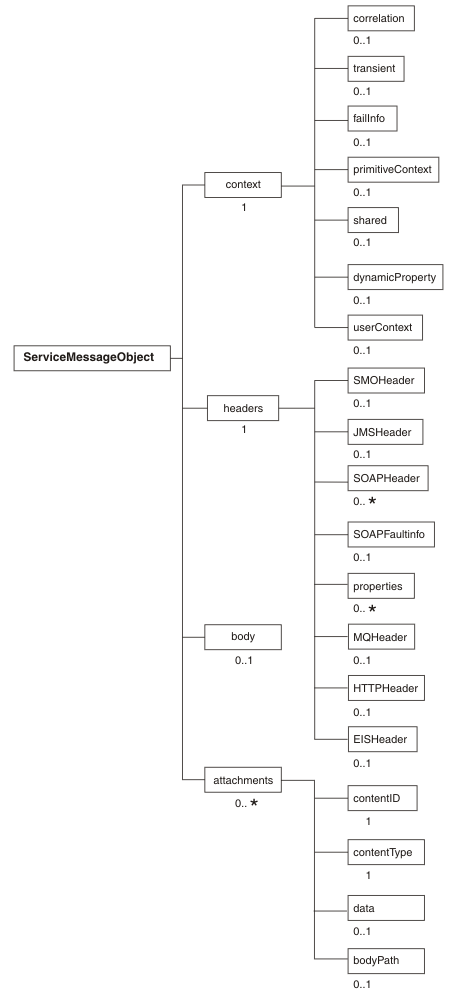IBM BPM, V8.0.1, All platforms > Programming IBM BPM > Enterprise Service Bus programming > Mediation Flow Component > Service Message Objects
SMO structure
All SMOs have the same basic structure. The structure consists of a data object called a ServiceMessageObject, which contains other data objects representing the header, body, attachments, and context data.
The structure of a SMO is shown in Figure 1 .
Figure 1. Overview of SMO structure. The context, headers, body and attachments of a ServiceMessageObject

The ServiceMessageObject Java™ interface provides access to the message headers, message body, message context and message attachments.
SMO headers
The SMO headers carry header information for different types of messages.
The SMO headers contain information that originates from a specific import or export binding (a binding specifies the message format and protocol details). Messages can come from a number of sources, so the SMO has to be able carry different kinds of message header. The kinds of message headers include:
- SOAP
- HTTP
- JMS
- WebSphere MQ
- SCA
- Web services
- WebSphere Adapters
SMO context
The SMO context lets mediation primitives pass data that is not part of the message payload, between themselves.
SMO context objects are either user-defined or system-defined.
System-defined context objects
The following context objects are system-defined:
- failInfo. The failInfo context object is used to hold exception information
- primitiveContext. The primitiveContext object contains information used by specific mediation primitives
- dynamicProperty. The dynamicProperty object is used to override promoted properties
User-defined context objects
User-defined context objects can be used to store properties that mediation primitives use later in the flow.
The following context objects are user-defined:
- correlation context is used for mediation primitives to pass values from the request flow to the response flow.
- transient context is used for passing values between mediation primitives in the current flow. Values in the transient context are not shared between the request and the response flows or between branches of the same flow.
- shared context is a storage area you can use if you want to aggregate data. The shared context is shared between all branches of a flow. It is not shared between the request and the response flows or between branches of the same flow.
- user context is slightly different to other user-defined context objects. It is used to pass data that is not part of the message payload, between multiple SCA components in the same module or across SCA module boundaries.
SMO body
The body of a SMO is a business object that is defined by reference to a Web Services Description Language (WSDL) message.
For each part defined by the WSDL message there is one element under the SMO body. The contents of the SMO elements are of the structure of the WSDL part definition. The element names depend upon the kind of WSDL message that the SMO is defined from.
SMO attachments
The SMO contains an attachments element for each attachment associated with a SOAP message.
The SMO attachments element let you send and receive SOAP messages that have attachments of various types.
You might want to send SOAP messages with attachments and let the attachments pass through the mediation flow unchanged, or you might want to create new attachments, perhaps from information in the message or from an external source.